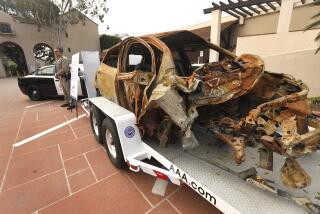Alcohol-Related Road Deaths Analyzed
- Share via
WASHINGTON — Native Americans and Mexican Americans are more likely than members of other ethnic groups to be killed in traffic accidents involving alcohol, according to the first study of ethnicity and drinking in highway deaths.
The research, commissioned by the U.S. Transportation Department and released Monday at a Miami conference sponsored by Mothers Against Drunk Driving, also showed that Asian Americans and Americans from the Pacific Islands are the least likely to be killed in alcohol-related crashes.
“As America becomes more diverse . . . showing the differences between ethnic groups will give health specialists a starting point for looking at new prevention ideas,” said lead researcher Robert Voas of the Maryland-based Pacific Institute for Research and Evaluation, which conducted the study.
Some Fear Numbers Could Be Misused
The findings, for example, eventually may lead to a wave of public service announcements on Spanish-language television highlighting the tragedies of Latino families involved in alcohol-related crashes.
But others fear that the numbers also could be misused by police to harass Latino and Native American motorists.
“I am hoping that law enforcement doesn’t use this to stereotype people for ‘driving while brown,’ ” said MADD board member Sammy Quintana, a former New Mexico prosecutor. Minority organizations have long complained that police pull over African Americans as well as Latinos merely for being on the highway, which has been dubbed “driving while black.”
The study analyzed 199,316 deaths in U.S. traffic accidents of all types from 1990 through 1994. It found that 46% of all the traffic deaths occurred in accidents where someone had been drinking.
An accident was counted as “alcohol-related” whether the people involved were legally drunk--and whether drinking caused the accident.
Wide Statistical Ethnic Differences
Breaking the numbers down by ethnic group yielded strikingly different patterns.
For example, 73% of Native Americans and 60% of Mexican Americans were killed in alcohol-related accidents, compared to 27% of Asian/Pacific Islander Americans and 44% of whites.
There were similar differences in the use of seat belts.
Among Latinos, Mexicans were the most likely to be killed in crashes involving alcohol, followed by Central and South Americans (51%), Puerto Ricans (45%) and Cubans (34%).
Among African Americans, 47% were killed in alcohol-related accidents, a slightly higher proportion than for whites. However, the study found that older African Americans were significantly more likely than older whites to be killed in crashes in which alcohol was a factor.
One finding held true across all ethnicities: Young men were more likely to be involved in alcohol-related accidents. “Drinking and driving is a young male problem and that cuts across ethnic groups,” said Voas.
Overall, alcohol-related traffic deaths have been steadily declining as a result of stronger drunk driving enforcement and education campaigns by MADD and other groups. Fatalities declined 27% in the last decade--from 22,084 in 1990 to 16,189 in 1997, the last year for which statistics are available.
Spokeswoman Lisa Navarrete of National Council of La Raza, a Latino advocacy group, said she is concerned that the study may aggravate a controversy over the deportation of immigrants with past drunk driving convictions. Tougher laws facilitate deportation of people with criminal records, and in some cases the federal government has attempted to deport immigrants with 10-year-old drunk driving convictions.
“We don’t want this to be used as an excuse to go after people,” said Navarrete. “We are in the prevention and public education mode on this.”
Voas cautioned against drawing sweeping conclusions from the study, saying that the data have yet to be adjusted for factors such as age differences among ethnic groups. An older population may partly explain the low alcohol-death rate among Cuban Americans, for example.
Data for Americans of Asian and Pacific Island origin are also hard to interpret, Voas added. The reason is that the statistical category lumps together people of dozens of different nationalities and ethnic groups.
“This category is completely artificial,” said Voas. “The people in it are quite different in culture.” A local study in a city with large numbers of Asian Americans might provide a sharper, more nuanced snapshot than national statistics, he said.
(BEGIN TEXT OF INFOBOX / INFOGRAPHIC)
Alcohol’s Impact
The percentage of traffic deaths where alcohol was a factor:
Native American: 73%
Mexican American: 60%
Central/South American: 51%
African American: 47%
White: 44%
Cuban American: 34%
Asian/Pacific Islander: 27%
Source: Pacific Institute for Research and Evaluation, Prevention Research Center
More to Read
Sign up for Essential California
The most important California stories and recommendations in your inbox every morning.
You may occasionally receive promotional content from the Los Angeles Times.













